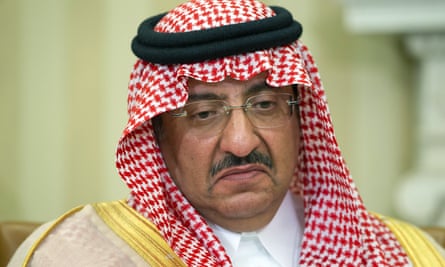
by Patrick Wintour — theguardian.com — Mohammed bin Nayef – the detained former Saudi crown prince and interior minister – has been the victim of a sustained and coordinated attack from inside Saudi Arabia on social media that risks endangering his personal safety, lawyers acting for him have warned. The lawyers have written to YouTube demanding it take down a video, saying the content claiming he had been plotting to bring down Crown Prince Mohammed bin Salman runs the risk of inviting serious retribution and harm to him. YouTube has not yet acted on the complaint. Separately, it has emerged that an apparently spontaneous surge in the number of tweets ahead of the US elections claiming Mohammed bin Nayef was part of a Democrat-led “deep state” plot to destabilise the Saudi Arabian royal family was orchestrated largely through bots run by supporters of Bin Salman, research shows.
The two developments serve to underline the perilous state of the 60-year-old Bin Nayef, who was close to the Obama administration and to then-vice-president Joe Biden. The former interior minister, seen as critical to bringing al-Qaida under control inside Saudi Arabia in the wake of the 9/11 attacks in New York, has been under house arrest since March. He was ousted as crown prince in 2017. A cross party group of British MPs has been denied access to him but is due to produce a report on his welfare before Christmas. The report is likely to call on the incoming Biden administration to press for his release. In the letter to YouTube, the lawyers point out the claims in the video that Bin Nayef has been at large and at one point seen next to Biden are totally false, and part of an elaborate conspiracy theory that he is working to undermine Mohammed bin Salman.
They point out “the true position is that our client has been detained against his will and without charge since March 2020 where he remains to this day. Our client has limited access to his family or lawyers and has been prevented from seeing a personal doctor who has been responsible for his treatment for many years. “Such communication as our client does enjoy is undoubtedly monitored. Both our client and our client’s family are concerned for their safety, and it is not known whether the lives of our client and our client’s family are in jeopardy.” The letter describes the video’s suggestion that he is plotting against the Saudi state as completely unfounded. “His loyalty to the crown prince had never wavered and he continues to support the established monarchy.” The Twitter campaign inside Saudi Arabia also alleges Mohammed bin Nayef had been part of the plot against his cousin, Bin Salman, that was uncovered by the crown prince. The tweets began two days after a call by Donald Trump in the final weeks of his election campaign for the release of more emails written by Hillary Clinton, some of which were supposed to show the Obama administration was plotting to undermine the Saudi royal family.
However, new research shows that at least 40% of the tweets denouncing the plot and the role of Bin Nayef were generated by what an independent agency has described as “bot-like behaviour”. The agency also claims the bots were seeking to pushing false narratives online and as the false narratives trend, persuade news outlets to pick up the story. The tweets, marked #HillaryEmails, sought to claim there had alleged been an effort to establish a “deep state” in Saudi Arabia, adding that Bin Nayef had been involved along with the then CIA cirector, John Brennan, and Clinton. The tweets claimed Bin Salman discovered the plot to bring down King Salman, and this led to the necessary downfall of Mohammed bin Nayef. The claims first appeared on Arabic Twitter accounts and at one point became the top-trending Twitter hashtag in Saudi Arabia, with more than 170,000 tweets. They were also repeated in Arabic-language media, most prominently Sky News Arabia. The Twitter campaign began after Trump, desperate for a way to eat into Biden’s poll lead, called for more of Clinton’s emails to be released.
Examining the Twitter campaign, Chris Padilla, the chief executive officer of digital reputation management specialists Legendary, said: “Given that our research estimates that over 40% of the accounts engaging with the HillaryEmails hashtag displayed bot-like behaviour, it is clear that the campaign is following a standard sequencing for disinformation campaigns. “A false narrative is published online, bots propagate it with great speed and reach causing the narrative and the false information to trend, and because it trends news outlets pick it up and cover it.”
On 13 October, Sky News Arabia ran an article entitled “The Clinton Secrets … how did the attempt to penetrate Saudi society fail?”, the claim that new messages relating to Clinton’s time as secretary of state were declassified but adding that they revealed that she had “communicated with some individuals inside Saudi Arabia” and that she had sought to measure her strength, also alleging that the emails include the names of figures in Saudi who support the Muslim Brotherhood. No official explanation has ever been given by the Saudi government as to why Mohammed bin Nayef has been detained, but a shifting list of allegations have been used ranging from the coup attempt, addiction, corruption, treason and conspiracy with the Obama administration. His supporters say that as interior minister he risked his life saving his country from al-Qaida and through credible security cooperation with the CIA, including with two directors John Brennan and George Tenet, salvaged the US-Saudi relationship after its collapse in the wake of the 9/11 attack on the World Trade Center.



